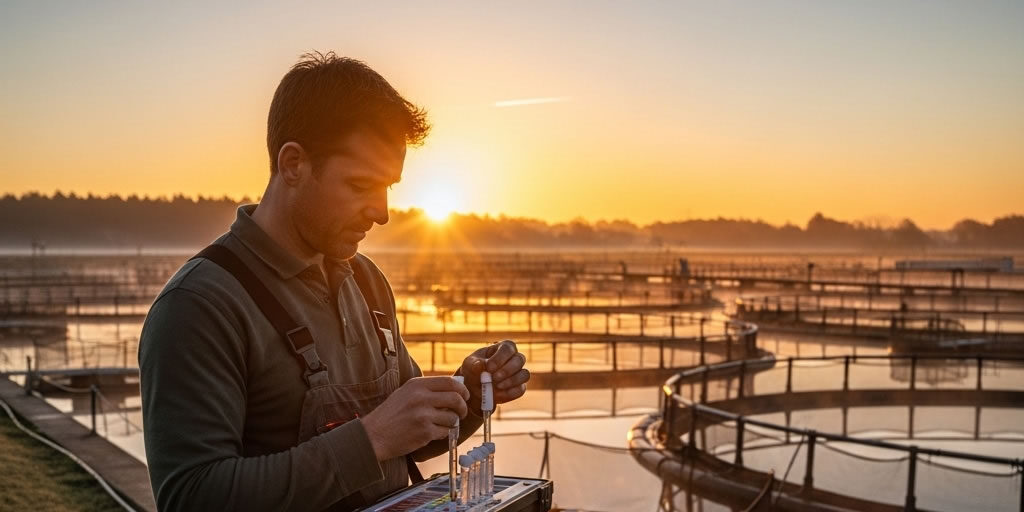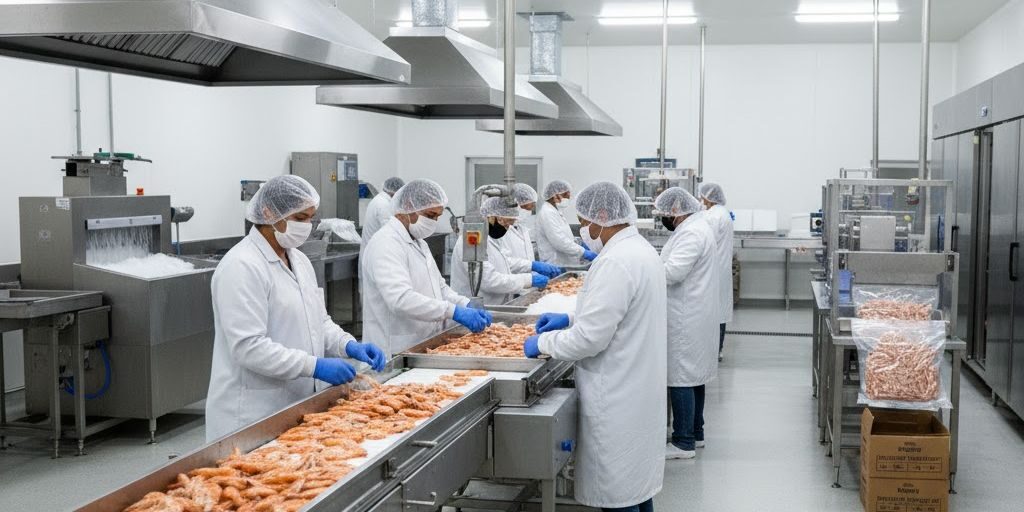- Software Gestor para Aquicultura
- (85) 2139-6730
- contato@despesca.com.br
Complete Guide to Water Parameters in Aquaculture

Calculation of production costs and pricing
14/08/2025
White Spot & IHHNV
19/08/2025How many times have you woken up worried about the health of your stock? The truth is, the biggest challenge in your production isn’t the fish or shrimp themselves, but what surrounds them: the water. It can be your greatest ally or the cause of catastrophic losses.
Many farmers still manage their ponds by guesswork, but the real enemies are invisible. Ammonia, nitrite, pH swings, and low oxygen levels don’t warn you before they strike.
This complete guide will demystify the 6 main water quality parameters. You will learn not only what to measure, but how to interpret the results and, most importantly, what to do to fix the problems. Let’s turn data into action and losses into profit.
1. Dissolved Oxygen (DO): The Life-or-Death Parameter
Think of dissolved oxygen as the air your stock breathes. Without it, everything else stops. A lack of DO is the number one cause of mass mortalities, especially overnight or on cloudy days.
- Why is it so Critical? Low DO levels cause severe stress, reduce feed consumption, worsen the feed conversion ratio (FCR), and in extreme cases, lead to suffocation and death in a matter of hours.
- Ideal Levels:
- Fish and Shrimp: Above 4 mg/L. Levels below 3 mg/L are dangerous, and below 2 mg/L are lethal for most species.
- How to Measure: Use a digital oxygen meter (more accurate) or colorimetric kits. The most critical measurements are at dawn (when DO is at its lowest) and in the late afternoon.
- How to Correct Low Oxygen:
- Immediate Action: Turn on the aerators immediately. Mechanical aeration is your primary tool.
- Water Exchange: If possible, perform a partial exchange with good quality, oxygen-rich water.
- Feed Management: Suspend feeding until DO levels normalize. Digestion consumes oxygen.
2. pH (Potential of Hydrogen): The Balance That Affects Everything
pH measures whether water is acidic, neutral, or alkaline on a scale of 0 to 14. This measurement seems simple, but an imbalance directly affects the health of your animals and the toxicity of other compounds, like ammonia.
- Why can’t you ignore it? Sudden pH shifts cause stress and damage the gills and protective slime coat of the animals. More importantly, a high pH drastically increases the toxicity of ammonia.
- Ideal Levels:
- Most cultured species: Between 7.0 and 8.5.
- How to Measure: Use a digital pH meter (probe) or test strips/colorimetric kits.
- How to Correct pH:
- Low pH (Acidic): The most common correction is the application of agricultural limestone (calcitic or dolomitic). The dosage depends on soil and water analysis.
- High pH (Alkaline): Often associated with algae blooms. Water exchange and controlling algae density can help stabilize it. Caution: Never make sudden corrections. The process must be gradual.
3. Alkalinity: Your pH’s “Airbag”
If pH is the direction your car is pointing, alkalinity is the suspension that absorbs the bumps in the road. It is the water’s capacity to neutralize acids, meaning it prevents the pH from swinging abruptly.
- Why should you care? Adequate alkalinity provides a “buffering effect,” protecting the pond from dangerous drops in pH. Without this “airbag,” the pH can plummet overnight, causing acute stress to your stock.
- Ideal Levels:
- Shrimp Farming: Essential for proper shell formation. The ideal is to maintain it above 80 mg/L of CaCO₃.
- Fish Farming: Above 40 mg/L of CaCO₃. Levels below 20 mg/L are considered dangerous.
- How to Measure: Use a titration kit, where you add a reagent drop by drop to a water sample until it changes color.
- How to Correct: The application of calcium carbonate (limestone) is the most common and safest method. Proper pond-bottom liming before the cycle begins is the foundation for good alkalinity.
4. Ammonia (NH₃/NH₄⁺): The Invisible Enemy from Within
Ammonia is the direct result of the decomposition of excess feed and animal waste. It is a highly toxic nitrogenous compound that, if left uncontrolled, will accumulate and poison your crop.
- Why is it Dangerous? In its toxic form (NH₃), ammonia burns the gills, impairs breathing, and opens the door to diseases. The proportion of toxic ammonia increases with higher pH and temperature.
- Alert Levels: Ideally, total ammonia should be kept below 0.5 mg/L. Levels above 1.0 mg/L require immediate action.
- How to Measure: Use colorimetric kits specifically designed for total ammonia.
- How to Control and Correct:
- Adjust Feeding: Overfeeding is the primary cause of high ammonia. Review your feeding rates.
- Increase Aeration: Proper aeration helps beneficial bacteria process ammonia more efficiently.
- Water Exchange: Exchanging water dilutes the ammonia concentration.
5. Nitrite (NO₂⁻) and Nitrate (NO₃⁻): The Consequences of the Cycle
Nitrite is the next step in the nitrogen cycle, formed by bacteria acting on ammonia. It is also toxic because it interferes with oxygen transport in the animal’s blood.
- The Danger of Nitrite: In fish, it causes “brown blood disease,” leading to suffocation even when DO levels in the water are high.
- Safety Levels: It should be kept as close to zero as possible. Levels above 0.1 mg/L are a warning sign.
- How to Control: The same measures for controlling ammonia apply here. A mature, well-oxygenated biological system will convert toxic nitrite into nitrate (NO₃⁻), which is far less toxic.
6. Transparency: The Window into Pond Productivity
Transparency, measured with a Secchi disk, is a simple indicator of the amount of microalgae (phytoplankton) in the water. This “green water” is the base of the food web, produces oxygen during the day, and helps absorb toxic compounds.
- Why should you care? Transparency reveals if your pond is in balance. Water that is too clear indicates low productivity. Water that is too murky indicates an excess of algae, with a high risk of oxygen depletion at night.
- Ideal Levels:
- Generally for fish and shrimp: Between 30 and 45 cm of Secchi disk visibility.
- How to Measure: Lower the Secchi disk into the water until it disappears from view and note the depth. The average between the disappearance and reappearance depth is your measurement.
- How to Manage:
- To Decrease Transparency (clear water): Use fertilizers to stimulate algae growth.
- To Increase Transparency (murky water): Perform a partial water exchange and consider reducing your feed rate.
What’s the Point of Measuring if You Don’t Record? The Importance of History.
Measuring parameters is the first step. But if that information ends up on a wet piece of paper or gets lost in notes, you are just “putting out fires.”
The real power lies in recording this data in an organized way. This is where professional management makes a difference. By entering your measurements into a system like Despesca, you create a powerful history of your pond.
With this history, you can:
- See Trends: Notice if ammonia is slowly rising over several weeks.
- Correlate Data: Understand how an increase in feed impacted oxygen levels at dawn.
- Predict Problems: Act before levels become critical.
- Make Fact-Based Decisions: Know the exact health and status of each pond.
Conclusion: Quit Guessing, Start Managing
Controlling your water parameters isn’t an expense; it’s the most important investment in your production. It’s the difference between a profitable cycle and a losing one.
Start measuring today, record every result, and learn from your system’s behavior. Transform the water from an invisible threat into your greatest production tool.




